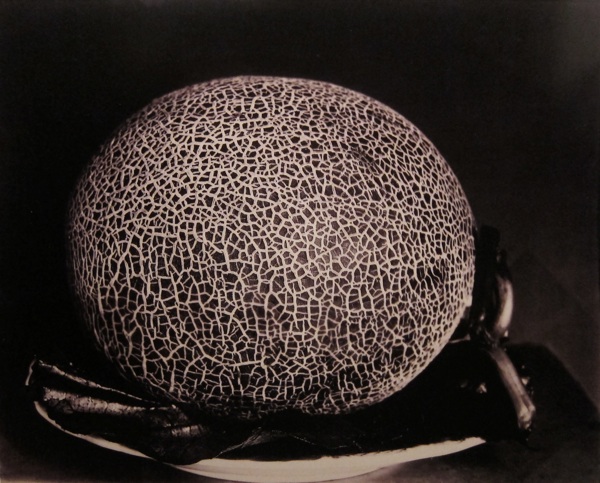Charles Jones, Photographer & Gardener

Tickets are available for my tour throughout August & September
Garden scene with photographer’s cloth backdrop c.1900
These beautiful photographs are all that exist to speak of the life of Charles Jones. Very little is known of the events and tenor of his existence, and even the survival of these pictures was left to chance, but now they ensure him posthumous status as one of the great plant photographers. When he died in Lincolnshire in 1959, aged 92, without claiming his pension for many years and in a house without running water or electricity, almost no-one was aware that he was a photographer. And he would be completely forgotten now, if not for the fortuitous discovery made twenty-two years later at Bermondsey Market, of a box of hundreds of his golden-toned gelatin silver prints made from glass plate negatives.
Born in 1866 in Wolverhampton, Jones was an exceptionally gifted professional gardener who worked upon several private estates, most notably Ote Hall near Burgess Hill in Sussex, where his talent received the attention of The Gardener’s Chronicle of 20th September 1905.
“The present gardener, Charles Jones, has had a large share in the modelling of the gardens as they now appear, for on all sides can be seen evidence of his work in the making of flowerbeds and borders and in the planting of fruit trees. Mr Jones is quite an enthusiastic fruit grower and his delight in his well-trained trees was readily apparent…. The lack of extensive glasshouses is no deterrent to Mr Jones in producing supplies of choice fruit and flowers… By the help of wind screens, he has converted warm nooks into suitable places for the growing of tender subjects and with the aid of a few unheated frames produces a goodly supply. Thus is the resourcefulness of the ingenious gardener who has not an unlimited supply of the best appurtenances seen.”
The mystery is how Jones produced such a huge body of photography and developed his distinctive aesthetic in complete isolation. The quality of the prints and notation suggests that he regarded himself as a serious photographer although there is no evidence that he ever published or exhibited his work. A sole advert in Popular Gardening exists offering to photograph people’s gardens for half a crown, suggesting wider ambitions, yet whether anyone took him up on the offer we do not know. Jones’ grandchildren recall that, in old age, he used his own glass plates as cloches to protect his seedlings against frost – which may explain why no negatives have survived.
There is a spare quality and an uncluttered aesthetic in Jones’ images that permits them to appear contemporary a hundred years after they were taken, while the intense focus upon the minutiae of these specimens reveals both Jones’ close knowledge of his own produce and his pride as a gardener in recording his creations. Charles Jones’ sensibility, delighting in the bounty of nature and the beauty of plant forms, and fascinated with variance in growth, is one that any gardener or cook will appreciate.
Swede Green Top
Bean Runner
Stokesia Cyanea
Turnip Green Globe
Bean Longpod
Potato Midlothian Early
Pea Rival
Onion Brown Globe
Cucumber Ridge
Mangold Yellow Globe
Bean (Dwarf) Ne Plus Ultra
Mangold Red Tankard
Seedpods on the head of a Standard Rose
Ornamental Gourd
Bean Runner
Apple Gateshead Codlin
Captain Hayward
Larry’s Perfection
Pear Beurré Diel
Melon Sutton’s Superlative
Mangold Green Top
Charles Harry Jones (1866-1959) c. 1904
The Plant Kingdoms of Charles Jones by Sean Sexton & Robert Flynn Johnson is published by Thames & Hudson
You might also like to read about
The Secret Gardens of Spitalfields
Thomas Fairchild, Gardener of Hoxton
Buying Vegetables for Leila’s Shop








































What amazingly beautiful photographs . I wonder if he just failed to get noticed and encouraged and so gave up on his dream . Maybe that was why he didn’t value his negatives . Maybe he felt he was “getting above his station” or maybe he was just happy to be who he was and didn’t seek any recognition beyond that which he gave himself . I hope he wasn’t an unhappy person . He was certainly very gifted.
Thanks for revisiting Charles Jones! I was so inspired by your earlier piece that I got the book and wrote about it myself: https://professorhedgehogsjournal.uk/?s=Ghostly
These are beautiful and would look lovely on a kitchen wall. The peas look pearlescent, almost like they are precious jewels.
This style of photography has undergone a bit of a niche revival in recent years among a few more arty photographers. They appear to be selenium toned, hence the very slight purple colour which is noticeably different from the more familiar sepia. Both types of toning help preserve the photographs, and I believe that was their original purpose rather than aesthetic reasons.
Beautiful portraits.